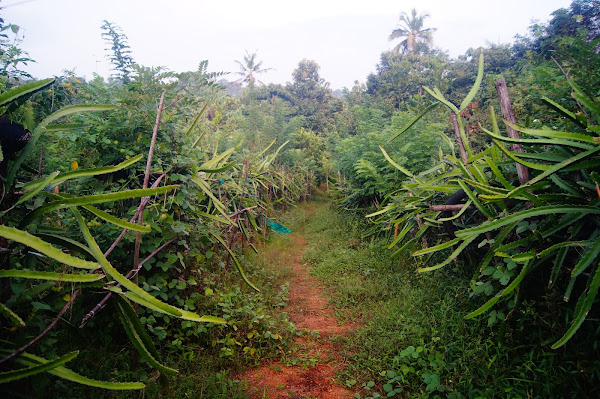A note on farm-forests- for beginners
The Beauty and Benefits of Farm Forests: A Sustainable Oasis
Whilst our farm-forest in Kulathupuzha is naturally a forest-integrated farm--- and vice-versa
But the default concept of a "farm forest" itself might not be familiar to everyone, it's an emerging practice that holds immense promise for the future of agriculture and our planet. Farm forests, also known as agroforestry systems, combine the traditional aspects of farming with the many benefits of forests. These multifunctional landscapes not only enhance biodiversity and sequester carbon but also offer farmers a sustainable and economically viable approach to land management. In this article, we will delve into the world of farm forests, exploring what they are, their advantages, and how they contribute to a more sustainable and resilient agricultural future.
What Are Farm Forests?
Farm forests are a blend of traditional farming and forestry, where trees, shrubs, and other woody vegetation are integrated into the agricultural landscape. They can take on various forms, from alley cropping (trees planted in rows with crops in between), silvopasture (combining trees and livestock), to windbreaks and riparian buffers (vegetation planted alongside water bodies). The key feature is the symbiotic relationship between the two components: trees and crops or animals. Farm forests promote sustainability, ecological balance, and economic viability, making them an attractive proposition for modern agriculture.
Benefits of Farm Forests:
1. Biodiversity Boost:
Farm forests act as ecological hotspots, supporting a wide array of flora and fauna. Trees provide habitat for birds, insects, and other wildlife, which can contribute to pest control and pollination. The diverse plant species and vegetation layers in these systems create niches for various organisms, promoting biodiversity.
2. Carbon Sequestration:
In the face of climate change, carbon sequestration is crucial. Trees in farm forests play a significant role in absorbing carbon dioxide from the atmosphere, locking it away in their biomass and soil. This helps mitigate climate change by reducing greenhouse gas emissions.
3. Soil Health Improvement:
Farm forests enhance soil health by preventing erosion, promoting nutrient cycling, and increasing organic matter content. The canopy cover also moderates temperature fluctuations, creating a more stable microclimate for soil organisms and plant roots.
4. Economic Viability:
Farm forests can be financially rewarding for farmers. They diversify income streams by providing wood, fruit, nuts, and other non-timber forest products. Additionally, they can reduce the need for chemical inputs and enhance crop yields, making the system more resilient to extreme weather events.
5. Water Management:
Farm forests help manage water resources by reducing runoff, improving water quality, and preventing soil erosion. Riparian forest buffers, for example, protect water bodies from agricultural runoff, maintaining aquatic ecosystems and providing recreational opportunities.
6. Erosion Control:
The root systems of trees in farm forests help stabilize the soil, preventing erosion. This is especially crucial in regions prone to land degradation, such as hillsides or areas with heavy rainfall.
In the upcoming blog posts, you will see how the local administration in Kulathupuzha has inculcated this in their project alongwith the help of thozhilurappu schemes, "Thozhilurappu" is a term in the Malayalam language, primarily spoken in the Indian state of Kerala. In Malayalam, "Thozhil" means work or employment, and "Urappu" refers to welfare or progress. Thozhilurappu, when used in the context of Kerala, typically signifies the state government's various initiatives and programs aimed at employment generation and the welfare of its citizens.
These initiatives and programs encompass a wide range of activities, policies, and projects designed to promote employment opportunities, skills development, and the overall well-being of the people in Kerala. Kerala has a rich tradition of social welfare and labor movements, and Thozhilurappu initiatives are often seen as part of the state's commitment to social justice and equitable development.
Their team will be at the farm forest in our location this week. (stay tuned for those updates)
7. Aesthetic and Recreational Value:Farm forests also offer aesthetic appeal and recreational opportunities for the community and farm owners. They provide a serene, shaded environment.
What we expect from the system at Kulathupuzha farm-forest:
Financial Support: Governments and organizations can offer financial incentives or grants to farmers who integrate agroforestry into their operations. These incentives can help cover the initial costs and encourage more widespread adoption.
Research and Development: Continued research into agroforestry practices, suitable tree species, and ecosystem services is essential. This research can provide valuable insights and data for farmers looking to implement farm forests.
Policy Support: Governments can enact policies that promote agroforestry, including zoning regulations, subsidies, and land use planning that incentivizes the integration of trees into farming landscapes.
And trust us, the farmers who do not harm the forest. But only live around them.
Farm forests offer a sustainable and multifunctional approach to land management that benefits the environment, biodiversity, and the economy. By combining agriculture and forestry, they provide a win-win solution for farmers and the planet. As we navigate the challenges of a changing climate and strive for a more sustainable future, the concept of farm forests has the potential to play a vital role in our collective efforts to build a resilient and prosperous world.





Comments
Post a Comment